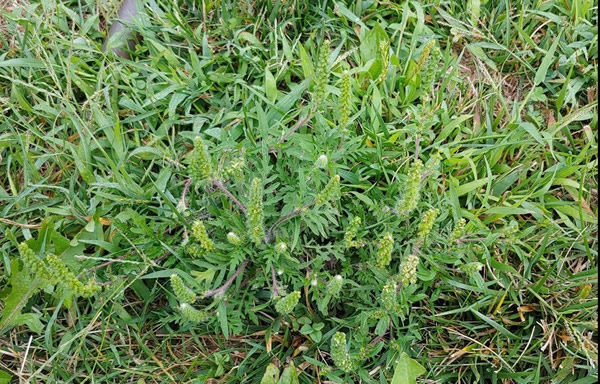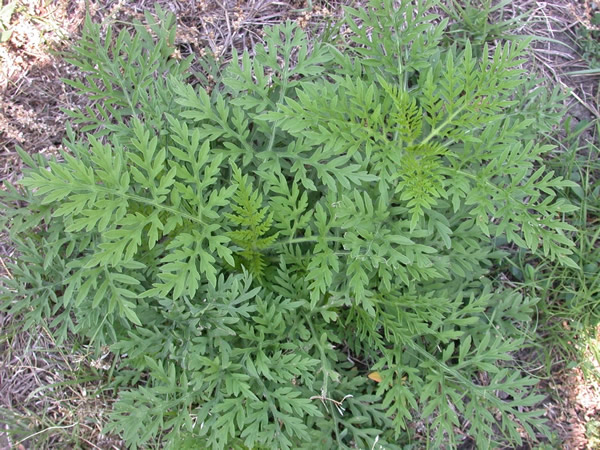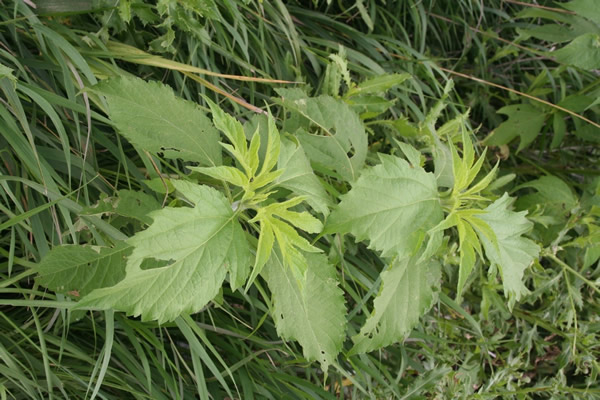Issue 11, September 13, 2019
Ragweeds in Lawns and Landscapes
If you suffer from pollen allergies this time of year, you are likely familiar with the ragweeds. Both common ragweed (Ambrosia artemisiifolia) and giant ragweed (A. trifida) are typically found in waste areas, fields, and rural roadsides. This year, however, I have seen common ragweed on more than one occasion happily growing in mowed turfgrass in an urban setting. I could maybe understand if it were growing in a rural lawn. Still, this is not a common lawn weed. To make matters worse, the ragweed was IN BLOOM. Take that, allergy sufferers! It’s growing close to the ground where you aren’t even looking for it.

Common ragweed in bloom in a lawn.
While both common and giant ragweed are related and similar in some aspects, there are noticeable differences. Both grow as erect, summer annuals with primarily fibrous roots. While common ragweed typically grows 1 to 4 feet tall, giant ragweed grows 4 to 8 feet tall, but in fertile, moist soils, it can reach 12-18 feet. While the leaves of common ragweed are mostly alternate, nearly smooth, and deeply cut into a number of lobes (fernlike), in contrast the leaves of giant ragweed are opposite, rough, hairy, and large with three to five lobes. Both plants have small, green, inconspicuous flowers that produce an abundance of pollen that is hazardous to hay fever sufferers. This quality is the reason that both ragweeds have earned a spot on the Illinois Noxious Weed Law species list.

Common ragweed in a landscape bed.
Certain weeds have been legally declared noxious by the Illinois legislature. Their control is required by law. The Illinois Noxious Weed Law states that “every person shall control the spread of” and “eradicate all noxious weeds on lands owned or controlled by him in the state of Illinois.” The law further states that, “whenever the owner or person in control of the land on which noxious weeds are present has neglected or failed to control or eradicate them . . . the control authority having jurisdiction shall have proper control and eradication methods used on such land, and shall advise the owner, person in control, and record holder of any encumbrance of the cost incurred in connection with such operation. The cost of any such control or eradication shall be at the expense of the owner.” In addition, the person shall be subject to a fine of not more than 100 dollars for the first offense and not more than 200 dollars for each subsequent offense. Bear in mind however, that enforcement authority lies at the county level and funding and personnel for these efforts aren’t always readily available. Some counties strictly enforce the Noxious Weed Law and others do not. My intent of this article is not to scare readers, but merely to make them aware.

Giant ragweed in a grassy waste area.
For lawns, ragweeds can be prevented with proper practices that would lead to a dense, actively growing turfgrass. Mow high to shade out weeds. Fertilize and water at appropriate times. Select adapted turfgrass that are well suited for your growing conditions. For landscape beds, mulch can be used to prevent seeds from germinating. Certainly, preventing existing weeds from producing seeds would be best. Preemergent herbicides such as isoxaben can be used in the spring to prevent ragweed. Plants can be removed by hand or with a postemergent broadleaf herbicide such as 2,4-D or a 3-way product in lawns. For best success, apply to young plants. For spot applications, glyphosate could be used, however, it is suspected there are glyphosate resistant populations in the state so adequate control may not be achieved with this active ingredient. Read and follow all product labels carefully.
Author:
Michelle Wiesbrook